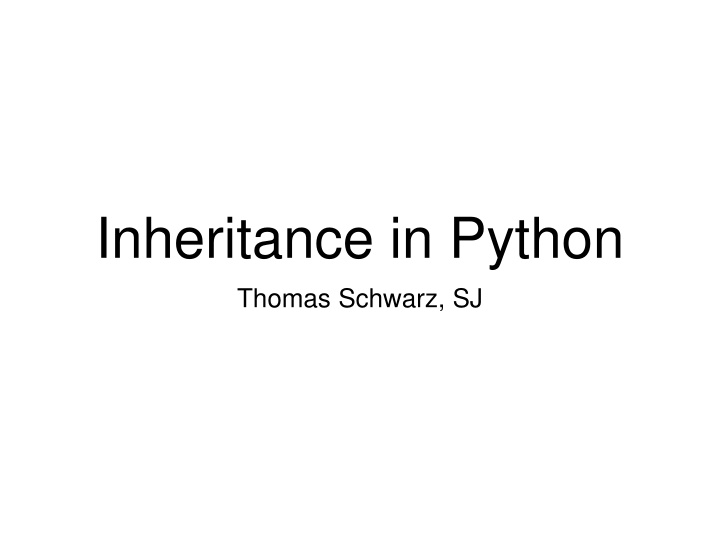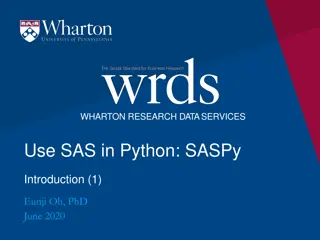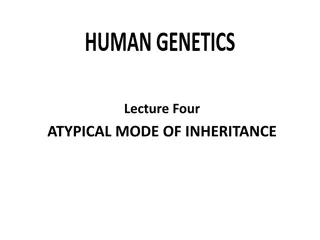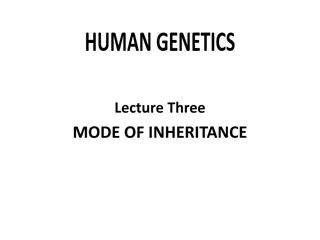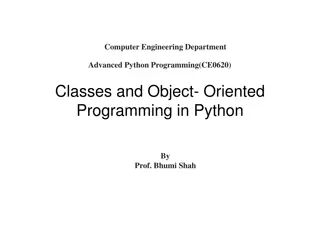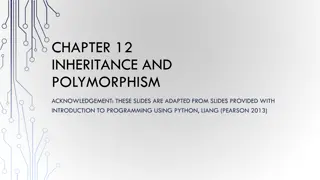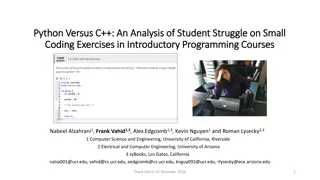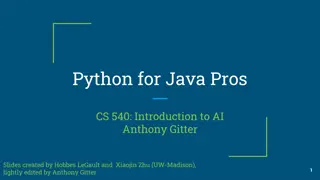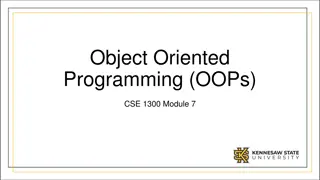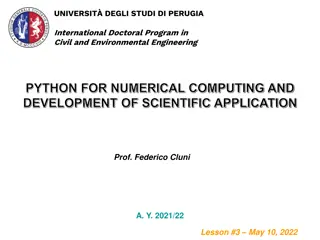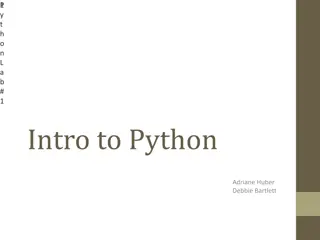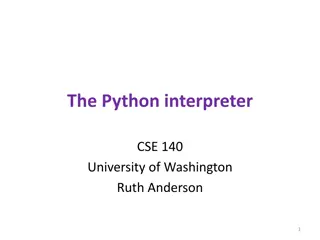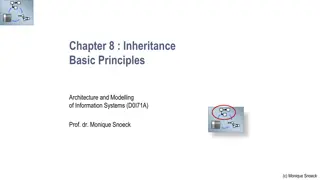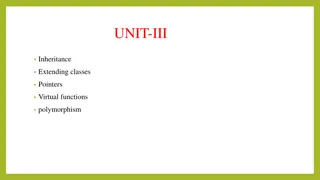Inheritance in Python
Inheritance in Python involves classes having other classes as components, expanding to form relationships like animal -> dog -> poodle. Learn how classes share data and functionality, implement common structures in base and derived classes, and more. Explore the common relationships between classes and methods, as well as the process of deriving classes.
Download Presentation

Please find below an Image/Link to download the presentation.
The content on the website is provided AS IS for your information and personal use only. It may not be sold, licensed, or shared on other websites without obtaining consent from the author.If you encounter any issues during the download, it is possible that the publisher has removed the file from their server.
You are allowed to download the files provided on this website for personal or commercial use, subject to the condition that they are used lawfully. All files are the property of their respective owners.
The content on the website is provided AS IS for your information and personal use only. It may not be sold, licensed, or shared on other websites without obtaining consent from the author.
E N D
Presentation Transcript
Inheritance in Python Thomas Schwarz, SJ
Inheritance Sometimes, classes have other classes as components: Clients have addresses Class Client has a field of type Class Address Sometimes, classes expand other classes Example: animal -> dog -> poodle The poodle is a dog, the dog is an animal Example: employee -> engineer (an engineer is an employee) employee -> first level manager (a manager is an employee)
Inheritance The manager and the employee share data and functionality If we implement them as classes: Manager Class and Engineer Class have common fields and common methods. This is a common phenomenon
Inheritance Graphics implementation: An app has a number of elements Buttons, Canvases, Labels, EntryBoxes, Icons, ... All these elements share: The idea of size (usually a rectangle in the app) Certain functionality
Inheritance We have identified two possible relationships between classes is_a objects of one class are also instances of another class Poodles are Dogs has_a objects of one class are fields (aka properties aka members) of another class
Inheritance These are of course not the only relationships between classes Methods can have arguments that are objects of different classes Methods can use one class as an argument and return an instance of another class etc
Inheritance We implement the common structure in a Base Class (aka. parent class) We implement the specifics in a Derived Class (aka child class)
Inheritance Example: Class Poodle is derived from Class Dog Class Dog is derived from Class Animal
Inheritance How do we do it: We first implement the parent class We then implement the child class We derive by putting the name of the parent in parenthesis in the definition of the child class class Parent: ... class Child(Parent): ...
Inheritance Example: Base Class is Person. A person has a name and a birthdate Derive a class Employee An employee is a person An employee has an annual salary
Inheritance Implement the base class (minimum): class Person: def __init__(self, name, birthday): self.name = name self.birthday = birthday def __str__(self): return '{} (born {})'.format(self.name, self.birthday) if __name__ == '__main__': abe = Person('Abraham Lincoln', 'Feb 12, 1809') doug = Person('Stephen Douglas', 'Apr 23, 1813') bell = Person('John Bell', 'Feb 18, 1796') print(abe, doug, bell)
Inheritance To derive the child class: In the constructor, add a call to the parent class constructor Then add new fields / properties class Employee(Person): def __init__(self, name, birthday, salary): Person.__init__(self, name, birthday) self.salary = salary
Inheritance Instead of calling the constructor of the parent class by name, we can also use the super method super( ) automatically gets the Parent class There is no self - parameter in the call class Employee(Person): def __init__(self, name, birthday, salary): super().__init__(name, birthday) self.salary = salary
Method Overriding In our implementation, we now have two __init__ dunder methods two __str__ dunder methods This is called method overriding Any object has a type, in this case, a class Depending on the object's class, the right method is invoked
Method Overriding Self-test: Create a dunder hash for Person, composed of the hash for name and birthday Create a dunder hash for Employee, composed of the hashes of person and the birthday
Selftest Solution class Person: ... def __hash__(self): return hash(self.name)+hash(self.birthday) class Employee(Person): ... def __hash__(self): return hash(self.name)+hash(self.birthday) +self.salary
Private Members of a Parent Class Many programming languages allow to make fields (aka properties) private The "private parts" joke Python does not use a compiler to enforce privacy In line with Perl: Perl doesn't have an infatuation with enforced privacy. It would prefer that you stayed out of its living room because you weren't invited, not because it has a shotgun Larry Wall
Private Members of a Parent Class Python enforces rules by convention Convention 1: If you want other programmers or yourself to leave the fields in a class alone, you preface them with a single underscore Convention 2: If you want to be 'embarrassingly private', use double underscores before
Private Members of a Parent Class Python enforces the double underscore rule by mangling Internally, properties with an initial double underscore are stored under a different name But the name is predictable, so you can break the rule after all But it would be very impolite Either making them private was a bad idea Or breaking privacy is horribly bad
Private Members of a Parent Class Let's change Person to have a private property I cannot thing of anything that makes sense, so lets use a nonsensical property code class Person: def __init__(self, name, birthday): self.name = name self.birthday = birthday self.__code = 'P'
Private Members of a Parent Class If I try to access it directly, I get an error: >>> abe = Person('Abraham Lincoln', 'Feb 12, 1809') >>> abe.__code Traceback (most recent call last): File "<pyshell#9>", line 1, in <module> abe.__code AttributeError: 'Person' object has no attribute '__code'
Private Members of a Parent Class But I can access it by using the mangled name: Mangler calls the field _<class name>__field >>> abe._Person__code 'P'
Comparison with other languages Object Oriented programming was introduced with two big advantages in mind: Code Reusability You do not need to re-implement a class from another project Modularity Simpler design Containment of errors: Easier to pinpoint a class implementation at fault These promises have been only partially fulfilled.
Comparison with other languages Code reuse: Rarely happens in practice other than through the implementation of libraries. For easier code reuse, C++ uses templates E.g. one list instead of list of integers, list of strings, etc. Python does this through 'duck typing' As long as something behaves like a duck, it is a duck
Comparison with other languages Modularity C++, Java enforce access restrictions These can be circumvented with dirty tricks Force programmers to redeclare fields as private, protected, public Python uses protection by "convention", not protection by compiler error If you want to, but you should not want to, you can declare fields private using the double underscore
Comparison with other languages Code Reuse: Inheritance allows us to reuse code written for a base class Inheritance becomes difficult when the diamond pattern is allowed: What happens if parents share a method with the same name What if one parent overwrites a grandfather method and the other one does not Grandfather Parent1 Parent2 Child
Comparison with other languages Multiple Inheritance: a class derives from more than one class Not allowed in Java, but allowed in Python and C++ If used, need to understand how Python resolves names of methods and fields
Comparison with other languages Interfaces: a type of class interface used in Java to assure that classes fulfill certain requirements e.g. a class implementing an interface has a hash method Python can use "Abstract Base Classes" to provide the same support Advanced topic
Comparison with other languages Python OO is easy if you stick with the basics If you want to do advanced stuff, there is more to learn
